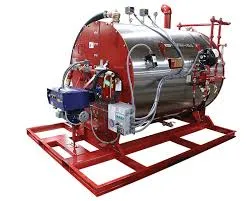
Nov . 23, 2024 21:59 Back to list
Boiler Steam Pressure Regulation and Control Mechanisms for Optimal Performance
Boiler Steam Pressure Control System Principles and Applications
Boilers play a critical role in various industrial processes by generating steam, which is essential for heating, power generation, and numerous other applications. The efficiency and safety of these boilers heavily depend on the effective management of steam pressure. A well-designed boiler steam pressure control system is fundamental to ensuring optimal performance, energy efficiency, and safety in operations.
Understanding Boiler Steam Pressure
Steam pressure in a boiler is a measure of the force exerted by steam within the boiler system. This pressure is crucial because it dictates the temperature of the steam and its capacity to perform work. When the steam pressure is too high, it can lead to equipment failure and safety hazards. Conversely, low steam pressure can result in inadequate heating or process inefficiencies. Therefore, maintaining the steam pressure within a specific range is paramount.
Components of a Steam Pressure Control System
A boiler steam pressure control system typically consists of several key components
1. Pressure Sensors These devices continuously monitor the steam pressure in the boiler and provide real-time data to the control system. Accurate measurement is critical for effective control.
2. Control Valves These valves regulate the flow of steam or water in the system. The control system adjusts these valves based on the pressure readings from the sensors to maintain the desired pressure level.
3. Control Logic This can be implemented through either analog circuits or digital controllers, such as Programmable Logic Controllers (PLCs) or Distributed Control Systems (DCS). Control logic interprets data from the pressure sensors and generates signals to actuate the control valves.
5. Safety Devices Safety valves and pressure relief devices are vital for preventing overpressure situations. In case of irregularities, these devices automatically release steam, protecting the boiler from potential damage.
boiler steam pressure control system

Principles of Control
The control of steam pressure in a boiler can be achieved through different strategies, primarily based on feedback control principles. One common approach is Proportional-Integral-Derivative (PID) control.
- Proportional Control adjusts the output based on the current error— the difference between the desired setpoint and the actual pressure. The proportional response helps to reduce the error to a certain extent.
- Integral Control addresses the accumulated error over time, correcting any persistent deviations from the setpoint.
- Derivative Control anticipates future errors based on the rate of change of the error, allowing the system to respond proactively.
The combination of these three control elements allows the system to maintain steam pressure within the desired range more effectively.
Applications in Industry
Boiler steam pressure control systems are utilized across various industries, including power generation, chemical processing, food production, and HVAC systems. In power plants, for instance, maintaining optimal steam pressure is vital for maximizing turbine efficiency and ensuring stable electricity generation. In the food industry, precise steam pressure control guarantees the proper cooking and sterilization of products.
Additionally, these systems contribute to energy efficiency. By maintaining appropriate pressure levels, facilities can optimize fuel consumption, reduce operational costs, and minimize greenhouse gas emissions.
Conclusion
The steam pressure control system in boilers is an essential component for ensuring efficiency, safety, and reliability in industrial operations. As industries continue to evolve and emphasize sustainability, advancements in control technologies, including automation and data analytics, are likely to play a significant role in further optimizing boiler steam pressure management. By prioritizing effective pressure control, industries can enhance their operational performance and contribute to a more sustainable future.
-
High-Efficiency Commercial Oil Fired Steam Boiler for Industry
NewsJul.30,2025
-
High-Efficiency Biomass Fired Thermal Oil Boiler Solutions
NewsJul.30,2025
-
High Efficiency Gas Fired Thermal Oil Boiler for Industrial Heating
NewsJul.29,2025
-
High-Efficiency Gas Fired Hot Water Boiler for Sale – Reliable & Affordable
NewsJul.29,2025
-
High Efficiency Biomass Fired Hot Water Boiler for Industrial and Commercial Use
NewsJul.29,2025
-
High-Efficiency Biomass Fired Hot Water Boiler for Industrial Use
NewsJul.28,2025
Related PRODUCTS






















